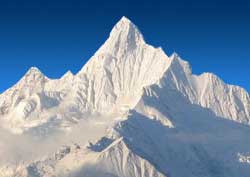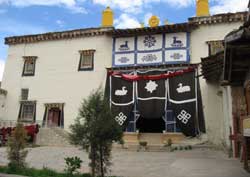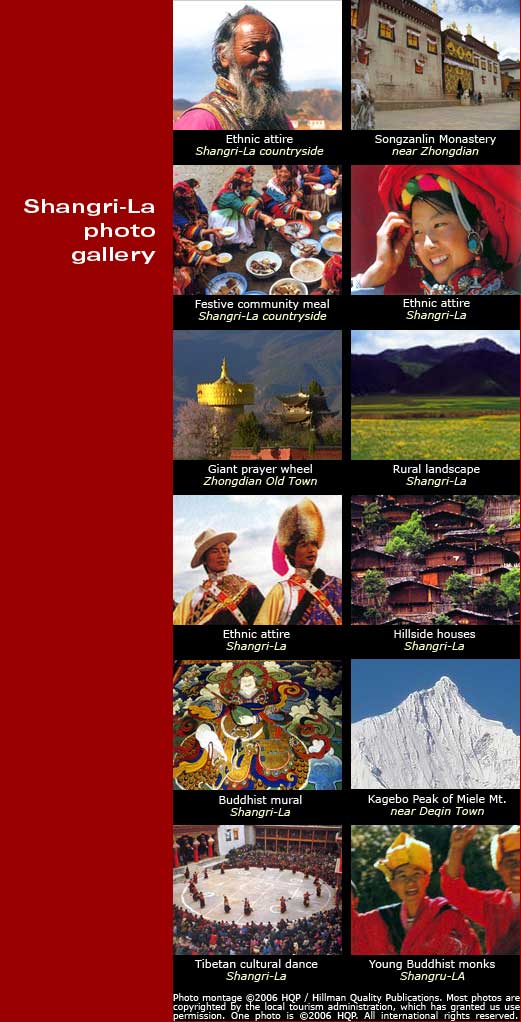Shangri-La Travel Guide
 What to see
and do in the
Shangri-La vicinity
What to see
and do in the
Shangri-La vicinityScenic beauty
Shangri-La is blessed with majestic mountains. Meili Snow Mountain is the most striking. Kagebo is its main peak (see photo). It stands 6470 meters (21,351 feet) high, has an imposing pyramidal top, and has never been climbed by man, though many have tried.
Taking a drive through the Shangri-La countryside is a must. You see beautiful green pastureland lightly populated with yaks, sheep and goats. You pass traditional thick-walled Tibetan farmhouses with painted window frames. You view women in their bright-hued ethnic costumes. Higher up, the road winds through dramatic mountain scenery.
Songzanlin Monastery
This large, sprawling, well-preserved lamasery was built in the 1700s by the Fifth Dalai Lama. It sits commandingly on a slope 5 kilometers (3 miles) north of Zhongdian. Temples and other buildings have ornate carvings and gilded highlights. The mystical sounds of chanting monks (numbering about 200) and clinging bells enrich the visitor's experience. Songzanlin (the Chinese name) is also known locally by its Tibetan name, Ganden Sumtzeling.
Tiger Leaping Gorge
This natural wonder can be visited on a day trip from Zhongdian. The roundtrip is about 350 kilometers (220 miles). Visitors witness an incredibly loud, churning, foaming river relentlessly pounding giant boulders in its path. Tiger Leaping Gorge is an unforgettable display of powerfully intense raw nature.
Spring is by far the best time to visit Tiger Leaping Gorge because the river turbulence is at its peak (melting snow flows down from the Himalayan mountains). Fall is the second best period because of its generally pleasant weather. Rains are heaviest during late summer.
There are two basic routes through the Tiger Leaping Gorge. One is the road that hugs the river. The second is by footpath which runs high above the river. The latter offers better adventure and vistas, but is recommended only to fit, experienced mountain trekkers as it is hazardously narrow and precipitous.
Zhongdian
The town of Zhongdian has both an old and a contemporary section. The latter lacks tourist appeal. However, the old town has interesting facets, including these:
- Ambiance
The reconstructed Zhongdian Old Town is not as large as its Lijiang counterpart, but is less commercialized and not as crowded with tourists (at least not yet). Its building designs are less polished and sophisticated, which lends a more genuine old town feeling.
- Tibetan dance
On most nights, town folk and countrysiders (many in their colorful traditional attire) gather in the main square starting at dusk. They form concentric circles to dance Tibetan style. You are welcome to join in. This community event is larger, more spirited than the one in Lijiang because its Sifang Square is bigger and because the town has a larger Tibetan ethnic population.
- Giant prayer wheel
An eye-catching 24-meter (80-foot) tall golden prayer wheel sits on a hill. Though it was built recently for the sake of tourism, it has become an authentic item because local Buddhists now climb the hill to spin it to submit their prayers. You can twirl it, too, but do it only clockwise, as religious tradition dictates.
Crystallized calcium carbonate deposits over countless millennia created a bizarre formation resembling frozen cascading water. Click the link below for page on this Hillman Wonder Bronze Medal world winner.
Baishui Terrace
 Best time of day
to visit the
Songzanlin Monastery
Best time of day
to visit the
Songzanlin MonasteryGo early in the morning or in the late afternoon to experience its tranquil character. It can be teeming with tour groups between those periods, especially in the late morning.
Photographing Songzanlin Monastery
- Indoor shots
Photographing inside the various temples is not allowed. External shots are okay (see photo).
- Viewpoint
There is a hill in front of the lamasery complex that offers a superb panoramic view (admission fee charged).
- Mid-April to mid-June
Rainfall is light and the colorful countryside wildflowers are blooming.
- Mid-September to November
Blue skies and crisp, refreshing air.
From January to mid-March, temperatures plummet and snowfall can be heavy.
Shangri-La vs Lijiang climate
When it's warm in Lijiang in the summer, it can sometimes be rather cold in Zhongdian. Play it safe. Pack layers.
More Shangri-La tips and insights
Driving distance
Zhongdian is 200 kilometers (125 miles) from Lijiang. The road is good-conditioned, but has many mountainous curves. Figure on a minimum of 4 to 5 hours. Kunming is nearly 500 kilometers (300 miles) away.
Windshield sightseeing
The drive from Lijiang to Zhongdian to Deqin offers spectacular mountain and valley vistas. The closer you get to Deqin, the more the culture, architecture, clothing, food and ethnic features become Tibetan.
Shangri-La to Lhasa
You can visit both Shangri-La and Tibet on the same vacation without having to take a long, roundabout, plane-switching trip (which used to be the case). There are now scheduled daily flights between Shangri-La (Zhongdian) Airport and Lhasa. There are also scheduled flights from Chengdu, Dali, Kunming, and Lijiang.
Zhongdian name confusion
Originally, Zhongdian bore a Tibetan name, Gyelthang (or Jianthang). In 1957, it was officially changed to the Chinese name Zhongdian. However, most local Tibetans still call their city by its earlier name.
Recently, Zhongdian Town was officially renamed Shangri-La (Xiangelila) for tourism purposes. However, most visitors (and many residents) still refer to it as Zhongdian.
Birth of the mountains
The tall, jagged peaks of Shangri-La were created by the same geological forces that formed the neighboring Himalayan Mountains (eons ago the vast tectonic Indian continental plate began sliding under the Asian one - and this process continues today, slowly elevating the mountains even higher).
Sunscreen
Shangri-La's high altitude means there is less atmosphere to filter out the sun's damaging ultraviolet rays. Therefore, it is easy to get sunburned without knowing it at the time, so wear a hat and apply a high-SPF sunscreen. I also recommend wearing sunglasses outdoors on sunny days. This advice is valid for Lijiang and Deqin as well.
Shangri La Photo



